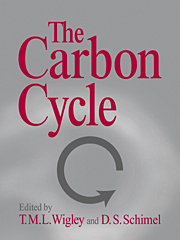Book contents
- Frontmatter
- Contents
- Preface
- Acknowledgments
- Contributors to the 1993 Global Change Institute
- I INTRODUCTION
- II THE MISSING CARBON SINK
- III PALEO-CO2 VARIATIONS
- IV MODELING CO2 CHANGES
- 14 Future Fossil Fuel Carbon Emissions without Policy Intervention: A Review
- 15 The Future Role of Reforestation in Reducing Buildup of Atmospheric CO2
- 16 Simple Ocean Carbon Cycle Models
- 17 Very High Resolution Estimates of Global Ocean Circulation, Suitable for Carbon Cycle Modeling
- 18 Effects of Ocean Circulation Change on Atmospheric CO2
- 19 Box Models of the Terrestrial Biosphere
- 20 Impacts of Climate and CO2 on the Terrestrial Carbon Cycle
- 21 Stabilization of CO2 Concentration Levels
- Part V Appendixes
- Index
19 - Box Models of the Terrestrial Biosphere
from IV - MODELING CO2 CHANGES
Published online by Cambridge University Press: 04 December 2009
- Frontmatter
- Contents
- Preface
- Acknowledgments
- Contributors to the 1993 Global Change Institute
- I INTRODUCTION
- II THE MISSING CARBON SINK
- III PALEO-CO2 VARIATIONS
- IV MODELING CO2 CHANGES
- 14 Future Fossil Fuel Carbon Emissions without Policy Intervention: A Review
- 15 The Future Role of Reforestation in Reducing Buildup of Atmospheric CO2
- 16 Simple Ocean Carbon Cycle Models
- 17 Very High Resolution Estimates of Global Ocean Circulation, Suitable for Carbon Cycle Modeling
- 18 Effects of Ocean Circulation Change on Atmospheric CO2
- 19 Box Models of the Terrestrial Biosphere
- 20 Impacts of Climate and CO2 on the Terrestrial Carbon Cycle
- 21 Stabilization of CO2 Concentration Levels
- Part V Appendixes
- Index
Summary
Abstract
We place box models within the hierarchy of terrestrial biosphere models used to assess atmosphere–biosphere carbon fluxes, develop the mathematical formulation of biosphere box models, and examine how gross and net fluxes resulting from land-use changes and CO2 and temperature feedbacks can be separately and simultaneously incorporated into box models. We then summarize insights gained from sensitivity studies using a globally aggregated biosphere model, and close with a proposal for combining the box model approach with some of the simpler regionally disaggregated process models.
Introduction
Balancing the carbon cycle at the global scale requires that one account for the observed cumulative and year-to-year buildup in the amount of atmospheric CO2 as the difference between emissions of CO2 and its uptake by various sinks. It is widely assumed that the natural carbon cycle was sufficiently close to steady state prior to human influence that emissions were exactly balanced by removal processes. Hence, the task of balancing the carbon budget for the time interval since the beginning of human influence requires deriving estimates of the human-induced perturbation in both emission and sink terms such that the difference between total emission perturbations and total sink perturbations equals the observed buildup.
- Type
- Chapter
- Information
- The Carbon Cycle , pp. 238 - 247Publisher: Cambridge University PressPrint publication year: 2000
- 3
- Cited by



